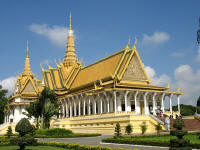| In the capital, we visited the royal palace (Cambodia is a constitutional monarchy). |
|
|
 |
|
|
|
|
|
|
|
|
|
|
Buddhist monks were a common sight in Phnom Penh |
|
discrimination against tourists |
|
|
A portable gas station |
kids play with a monkey in the park |
A cloth market in Phnom Penh |
the fruit she carries on her head looks like shower heads |
|
A traffic circle at night |
|
a child plays on the sidewalk next to her mother’s fruit stand |
beggar kids follow Zac asking for money |
|

|
|
|
|
|
In the capital, Phnom Penh, the roads are normal, but just outside the city center there are dirt roads. We got to experience these roads first-hand when we took a tuk-tuk (cart attached to the back of a motorcycle) to see the Killing Fields just 11km outside of the center. It was a bumpy, dusty ride. The Killing Fields, as the name implies, is where the Khmer Rouge killed people and piled them into mass graves. When we arrived there, we were met by a tall pagoda stacked high with nearly 9,000 human skulls which had been found in the parts of the field which had been excavated around 1980. The guide books had foretold this site, but there is nothing quite like the real thing and I burst into tears. We walked around the field and looked at the pits where the skeletons had been found. Some scraps of cloth were poking out of the dirt, and there were even some bones piled up under a tree. The killing fields hold far more though, as about 60% has not been excavated.
|
|
|
|
|
After I finally managed to quit crying, we went inside the pagoda with the skulls. The skulls at eye level were neatly arranged and classified by gender and age, but higher up, they were just piled on the dusty shelves—the few remaining teeth biting into the skull below and the hollow eye sockets staring vacantly. The sheer rawness of the memorial is what made it so powerful. Yet, even more disturbing than being in a room with 9,000 heads that had been clubbed to death was how quickly I got used to it.
|
|
|
|
|
After that, we went to a school which was turned into a prison by the Khmer Rouge and now serves as a museum and memorial for the atrocities committed there. This was the prison where people were tortured until they made up political crimes that they did not commit. These “crimes” were meticulously recorded (along with mug shots of the perpetrators) to provide evidence for why the people were then taken to the killing fields and bludgeoned to death.
|
|
|
|
|
|
|
|
About 20,000 people came through the prison and only 7 survived to tell the tale. The rest are still under the ground or have their skulls displayed as a gruesome reminder of the effects of extreme communist paranoia under the leadership of Pol Pot. During the Khmer Rouge regime, a quarter of the population in Cambodia either starved to death or was killed. The museum was intense and consisted mostly of photos of the victims—their pictures taken along with their fabricated confessions. It was weird to look at the floor in the photos (some depicting the torture) and realize it was the same exact floor we were walking on, blood stains and all.
|
|
|
|
|
|
|
|
|
|
|

|
|
|
|
|
|
|